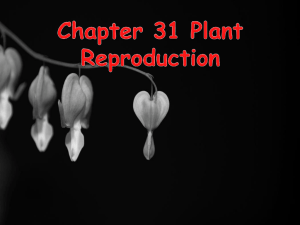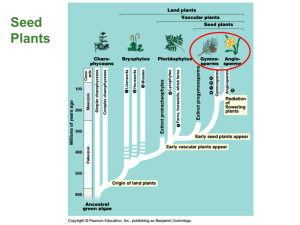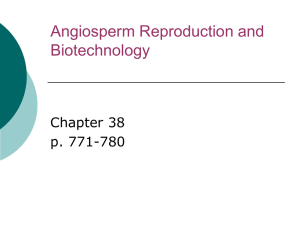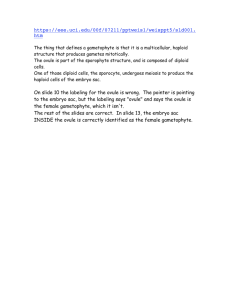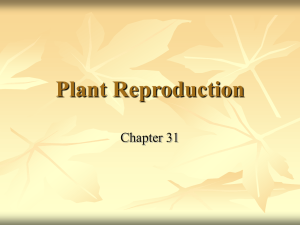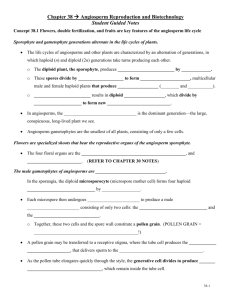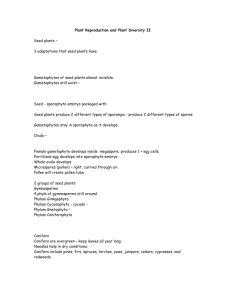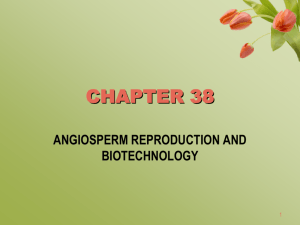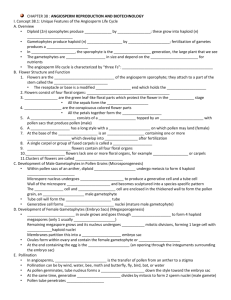File ap notes chapter 38
advertisement
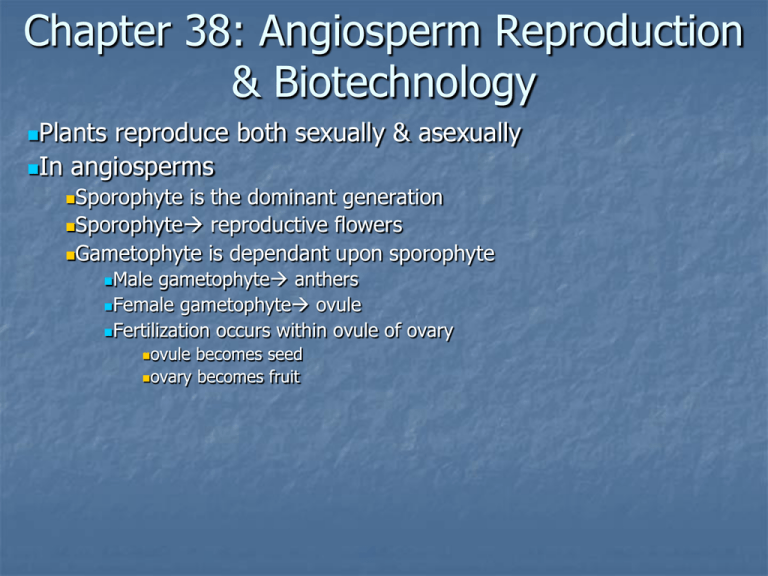
Chapter 38: Angiosperm Reproduction & Biotechnology Plants reproduce both sexually & asexually In angiosperms Sporophyte is the dominant generation Sporophyte reproductive flowers Gametophyte is dependant upon sporophyte Male gametophyte anthers Female gametophyte ovule Fertilization occurs within ovule of ovary ovule becomes seed ovary becomes fruit Floral Structure Determinate shoots attached to stem at receptacle 4 whorls Stamens & carpels= reproductive organs Stamen (male) Carpel (female) Filament=stalk Anther=terminus to filament in which pollen is located Pistil=single or fused carpel Ovary at base Style= slender neck of carpel stigma= sticky top of style for capturing pollen Ovules located within ovary Sepals & petals = sterile Sepal- protect flower organs Petals- attract pollinators Gamete development & pollination Male Pollen sacs (microsporangia) contain microsporocytes (2n) that form microspores (n) Any microspore can become a male gametophyte Microspore divides by mitosis generative cell & a tube cell Pollen grain=generative cell + tube cell + spore wall Maturation of generative cell occurs within the tube cell Tube cell will form pollen tube Generative cell divides to form 2 sperm cells Female Megasporangium in ovary of ovule Megasporocyte (2n) divides to form megaspores (n) In most angiosperms: 1 of 4 megaspores survives Surviving megaspore divides without cytokinesis to form a large cell with 8 haploid nuclei Large cell partitioned in gametophyte embryo sac Embryo sac has 3 cells at one end 1 egg 2 synergids (attract/guide pollen tube) Rest of embryo sac= 3 antipodal cells & 2 polar nuclei Pollination Transfer of pollen from anther to stigma Accomplished by: wind H2O Insects bird or animal transfer Preventing self-fertilization in Dioecious species Stamens & carpels Mature at different times Arranged to prevent selfing Self-incompatibility Plant rejects pollen of closely related species biochemical or pollen tube formation block Based on ability to recognize self from non-self Results from S genes Double fertilization 1 sperm fertilizes egg= zygote Other sperm combines with 2 polar nuclei to from triploid (3n)=endosperm Endosperm= food storing tissue of seed Endosperm develops only in ovules with a fertilized eggconserves nutrients After double fertilization Ovule=seed Ovary=fruit Endosperm function often taken over by swelling cotyledons of the fruit Embryo development Zygote divides to form Basal cell Form suspensor anchors embryo to parent Terminal cell Gives rise to most of embryo Divides to form proembryo cotyledons Shoot apical meristem located in shoot apex between cotyledons Opposite shoot apex=root apex with the root apical meristem Mature seed structure Last stages of development Seed dehydrates Seed coat forms from integuments of ovule Embryo becomes dormant & enclosed within the seed coat Ovary to fruit While seeds develop from ovules flowers develop into fruit to protect seeds & aid in their dispersal Caused by hormonal changes triggered by fertilization Ovary wall=pericarp (thickened wall of fruit) Seed germination Dormancy of seed must be broken by favorable conditions &/or environmental cues Seed to seedling Germination dependant on imbibition Seed expands & ruptures its coat Triggers metabolic changes Radicle Uptake of H2O due to low Y of dry seed Embryonic root First to emerge Shoot Hypocotyl hook forms to break soil surface Light causes hypocotyl hook to straighten Raises cotyledons & epicotyl epicotyl forms leaves Cotyledons shrivel & fall away Monocots- coleoptile pushes up through soil; shoot tip grows from coleoptile Asexual reproduction in plants Large amount of seeds are produced sexually to compensate for those lost to herbivores & environmental hazardscostly energetically; Some species choose asexual reproduction as a result of that cost Asexual reproduction=vegetative reproduction Offspring are usually mature, vegetative fragments of parent distributed locally Offspring at higher risk of local extinction if catastrophic event of new parasite occurs Mechanisms for asexual reproduction Fragmentation Apomoxis Shoot or stem cutting with callus (mass of dividing cells) develops adventitious roots or nodes that develop into whole plant Grafting Seeds produced without pollination or fertilization Diploid cell in the ovule gives rise to embryo & mature seeds Clones from cuttings Separation of parent plant into parts that develop into whole plants Young twig or bud grafted onto a closely related species Combines qualities of both plants Stock=plant that contributes root system Scion= twig grafted onto stock In vitro cloning of plants Make multiple copies Use for production of Genetically Modified Organisms (GMO) Foreign gene inserted into plant genome; plant expresses foreign gene Plant Biotechnology, Agriculture, & the consequences Artificial selection Manipulating reproduction & genetic make-up of plants for human benefit Biotechnology Used to insert genes into crops which Increase crop yields through pest resistance Increase nutritional value of crops Consequences of GMOs Increase in food allergies Adverse effects on non-target organisms Possible “superweeds”

